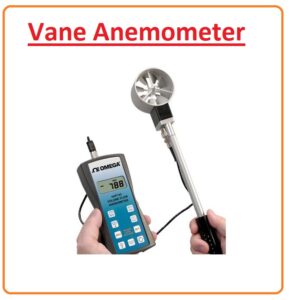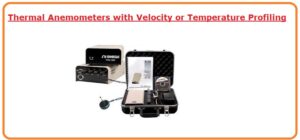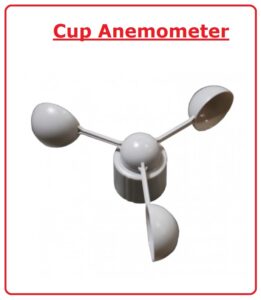 Hello friends I hope you all are doing great. In this post, we will have a detailed look at Introduction to Anemometer. An anemometer is a tool that works to calculate the speed of air moreover in a confined flow, like air movement in a tube, or in unconstrained movements, like an environmental breeze. To govern the speed, an anemometer senses alteration in certain physical chattels of the liquid or the outcome of the liquid on an automatic expedient injected into the flow.
Hello friends I hope you all are doing great. In this post, we will have a detailed look at Introduction to Anemometer. An anemometer is a tool that works to calculate the speed of air moreover in a confined flow, like air movement in a tube, or in unconstrained movements, like an environmental breeze. To govern the speed, an anemometer senses alteration in certain physical chattels of the liquid or the outcome of the liquid on an automatic expedient injected into the flow.
The warm cord anemometer is the utmost prevalent type of persistent temperature anemometer. It contains an electrical excited, adequate rope element (0.00016 inches in diameter and 0.05-inch length) sustained by pointers at its finishes. Although warm lead anemometers are the finest for unsoiled air at small speeds, venturi meters can also be deliberated for certain fluid (containing slurry) movement submissions.
Introduction to Anemometer
- An anemometer is a tool that works to calculate the speed of airs moreover in a confined flow, like air movement in a tube, or in unconstrained movements, like an environmental breeze.
- It is mostly used for airspeed calculations by the revolving-cup electric anemometer, in which the rotating cup enterprise an electric generator. The current produced by the generator activates an electric meter that is regulated in breeze velocity.
- The worthwhile assortment of this module is around from 5 to 100 knots. A propeller can also work to enterprise the generator, as in the propeller anemometer.
- This apparatus is particularly suitable for the measurement of less air velocity.
- The point is that a flow of air will chill a hot entity (the rate of chilling can be measured by the velocity of the air movement) is the standard underlying the warm lead anemometer.
- An electrically hot good rope is positioned in the air movement. As the air movement surges, the wire becomes chills.
- in the common category of heated wire anemometer, the constant-temperature sort, power is amplified to preserve a continuous wire temperature.
- The applied power to the warm wire is then a measure of air velocity, and a device in the electrical circuitry of the warm wire can be adjusted to designate air velocity.
- This scheme is convenient for low air velocity, under around 5 miles (8 km) per hr. The kata thermometer is a warm liquor thermometer the time it receipts to cooling is noted and used to govern air current.
- It is convenient for calculating small speeds in studies of air movement.
- A stream of air colliding the exposed end of a pipe fastened at the other end will shape up the pressure in the pipe.
- The change in pressure amid the inner of this pipe and the neighboring air can be measured and changed to airspeed.
- Pitot tubes are also used to calculate the flow of fluids, mainly in the sequence of cascade readings in fluid mechanics.
- This anemometer is very valuable, though, in robust, fixed air brooks, such as in wind subways and on-board aircraft in flying. With some alterations, it can be cast-off to calculate supersonic air movement.
Types of anemometers
- There is a varied variety of anemometer replicas for nonstop measuring wind and airspeed. The four maximum prevalent anemometer simulations are Vane Anemometers, Thermal Anemometers, Thermal Anemometers with Velocity / Temperature Profiling, and Cup Anemometers. Let’s discuss them one by one.
Vane Anemometers
- Methods of revolving motorized speed anemometers can be defined as fitting to the vane or propeller type.
- For this type of anemometer, the axis of revolution should be similar to the direction of the breeze and so characteristically parallel.
- In exposed places, the breeze differs in the way and the axis has to follow its variations. In belongings where the way of the airwave is permanently similar, as in the aerating tubes of collieries and houses, for example, breeze vanes, recognized as air meters are engaged, and provide the utmost acceptable consequences.
- Vane anemometers are existing with extra purposes like temperature, moisture and precipitation fact measurements, volumetric change, and statistics cataloging capability.
Thermal Anemometer
- Thermal anemometers use a good cable (on the imperative of numerous micrometers) or component excited up to certain temperature beyond the ambient temperature.
- Air moving over has a chilling consequence. As the electrical opposition of utmost metals is reliant on the temperature of the metallic (tungsten is a general option for warm leads), a connection can be got amid the resistance of the cable and the movement speed.
Thermal Anemometers with Velocity
- Thermal anemometer outlining schemes have the least obtainable device. The devices calculate both speed and temperature.
- The multiple point data sorting scheme permits the operator to outline movement features in the request and examine the statistics clearly.
- These are usually used in breeze subways for circuit panel and temperature basin examination.
Cup anemometer
- A modest category of anemometer is the cup anemometer. It contained three or four semicircular cups all riding on one end of flat arms, which in turn were fixed at equivalent angles to each other on a perpendicular shaft.
- The air moving past the cups in any parallel way twisted the cups in a way that was proportionate to the breeze’s rapidity.
- Consequently, calculating the turns of the cups above a fixed time retro created the typical wind swiftness for a varied variety of speeds.
- On an anemometer with four cups, it is tranquil to get that meanwhile the cups are settled regularly on the end of the limbs, the breeze always has the echoing of one cup offered to it and is blustering on the posterior of the cup on the reverse end of the cross.
Applications of anemometer
- It is used to calculate the velocity of the wind.
- It is used at the weather station to measure wind speed.
- It also works to calculate the pressure of air.
- We can also use it to know about wind direction.
- It is also used for inspection the movement of the breeze
Read also:
- What Does an Anemometer Measure, Types & Work Process
- What is Hot Wire Anemometer? – Definition, Working Principle, Construction
- Vane Anemometer working, Applications, Diagram, Advantages
- Introduction to Cup Anemometer
- Diagram of a Gas Water Heater | Water Heater Parts Diagram
Faqs
- Anemometers measure wind speed with wind pressure over the surface like a cup or propeller. or with the use of sonic pulses. A mechanical anemometer comes with a wheel having cups or propellers at the spokes of the wheel. Anyone has magnet
- For measuring the flow of wind. and measuring the direction of wind.
- it is used in drones or RC planes users to check weather conditions before testing devices
- Anemometer measures the number of rotations, that are used for measuring wind speed. The anemometer is a device that measures wind speed and wind pressure. It is best for meteorologists, who study weather patterns.
- Hold the meter facing the wind, cups or blades of devices must be at 90 degrees to the direction of the wind. Spin the wheel or crank on the anemometer until all cups are spinning. On this phase check the scale and note reading.
What are the disadvantages of an anemometer?
- The velocity of the anemometer is high
- It is not best to measure low values.
- in turbulent conditions, cup anemometers can underrate the wind speeds.
- Rotating parts wear out with time.
- it is sensitive to icing effect
- The ratio of wind speed and shaft speed is known as the anemometer factor and changes based on the construction of unit normally has a range of 2 to 3. Wind speed is measured as Instantaneous Wind Speed = Anemometer Factor x Instantaneous Shaft Speed.
- The anemometer operated on converting mechanical energy into electrical energy. These measuring features find the value of wind speed velocity and direction by evaluating contained or unconfined airflow.
- The working of an anemometer is simple and there is not changes made since 1846. it comes with 4 or 3 cups that rotates when wind starts to flow, and connected with arms that are connected with vertical rod up at some height with pole
That is all about Anemometer if you have any further queries ask in the comments. Thanks for reading. Have a nice day.










